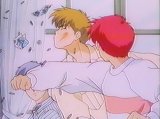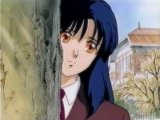

Quick Links:
Here is Greenwood
Here is Greenwood is a funny, sometimes dramatic, look at modern high school life in Japan. The story is set at Ryokuto, a private boy’s school on the outskirts of Tokyo. The main focuses of the show are the residents of Ryokurin dorm. Everyone calls this place “Greenwood,” because it’s “easier to say than Ryokurin - but also because Greenwood was the euphemism for the areas of forest in England inhabited by bandits and outlaws. In other word, Greenwood houses the unusual students at the school. Examples include, a guy who started a cult, roommates who have turned their room into a video arcade (a profitable one, at that), and an upperclassman that lives with his motorcycle.
However, the main character is new student Kazuya Hasukawa (affectionately called Suka-chan - meaning ‘nothing’), surrounded by his friends - Shun Kisaragi, who is in his class, and upperclassmen Mitsuru Ikeda and Shinobu Tezuka. Explaining any more about these characters would destroy the joy of watching how they are unveiled in the show - sometimes slowly over several episodes. All I’ll say for now is that the first episode lays out Hasukawa’s infamous bad luck - explaining that Hasukawa refuses to return home from school because his brother married Hasukawa’s first love.
Greenwood is a series of six OVAs that were first released in 1992 and were based upon Yukie Nasu’s fantastic manga series. The odd thing about the series is that the OVAs do not follow chronological order. I would actually recommend watching the second episode last, because it does indeed occur after the last episode and is a ‘sequel’ of sorts to a section of the manga that was never recounted in the OVA series.
The stories are very funny and sometimes moving. The OVAs were able to really pull out the heart of the manga and use it to great effect. By the end of the series, a real affection for the characters can begin, although its difficult to say where you started caring about them. I definitely wanted to see more and experience more of their adventures.
The first episode is the hilarious introduction of Hasukawa to Greenwood and Ryokuto. The second is probably the weakest of the episodes and focuses more on Shinobu. The third is an awesome episode about the dorm making a fantasy movie for a school fair; it’s a great ensemble piece with every character getting some good parts and you have to check out the incredible homage to Castle of Cagliostro during the closing. The fourth is the ubiquitous Japanese ghost story, focusing on Mitsuru - very funny! The fifth and sixth are a two-part story arc focusing on Hasukawa’s second love. Its funny and sad, and I consider it to be one of the finest examples of why anime rocks. It’s the perfect balance to something like Akira or Ghost in the Shell; this is a totally human story that most of us have experienced in some form during our lives.
The animation in the series is quite good for the content, as is the direction. Although the actual animation itself will not win any awards, the use of colors is phenomenal. The character designs are so integrated with the use of color and shading that any attempt to separate them would destroy the effect. The bright color of the characters’ hair and eyes is very unique, and, while standing out, becomes very acceptable during viewing. The attractive character designs, along with the excellent pacing and direction, make this a show I’ve been able to watch over and over without getting bored.
The music fits the series perfectly, although it isn’t necessarily good for listening apart from the series. The instrumental parts very much serve the show, rather than stand on their own (which is quite different from Kimagure Orange Road, the most similar anime series you can compare). However, the few vocal songs are outstanding, including the closing “No-Brand Heroes.” The ‘soundtrack’ is available in the US for about $15. Most of the songs are image songs, but they are performed by the cast of Greenwood. I do recommend the CD, especially since it does include the few songs that made it into the OVA.
I’ve only got a few complaints about this series. Firstly, the English dub is not very good - definitely watch the subtitled version unless a new dub is completed. Secondly, one of the episodes is quite dependent on the manga, and since it is actually the second episode, it may turn some viewers off before they get to the good stuff. Also, besides showing how well the main characters work together, this second episode isn’t all that strong of an episode. Thirdly, the series is too short. That can’t really be considered too much of a complaint, but of all the series I’ve seen, this is the one I’d like more episodes of the most.
If you enjoy Japanese culture, and like situational comedies with a hint of drama, you can’t go wrong with Here is Greenwood. While it is outside the mainstream, the quality of the production can’t be denied. This series comes highly recommended
A quick note about this review: it was based on the laserdisc version released in the US. Unfortunately, there has been no announcement of a DVD release, yet. VHS tapes can still be found. I highly recommend this series, and it is unfortunate that it was released before the maturation of the anime segment in the US. I recommend contacting Software Sculptors to show your support for a DVD release. I’d buy it!
Distributor: Software Sculptors Creator: Victor / Pierrot Project Released: 1991
Plot: A Character Design: A+ Animation Quality: A Music: A Overall: A



